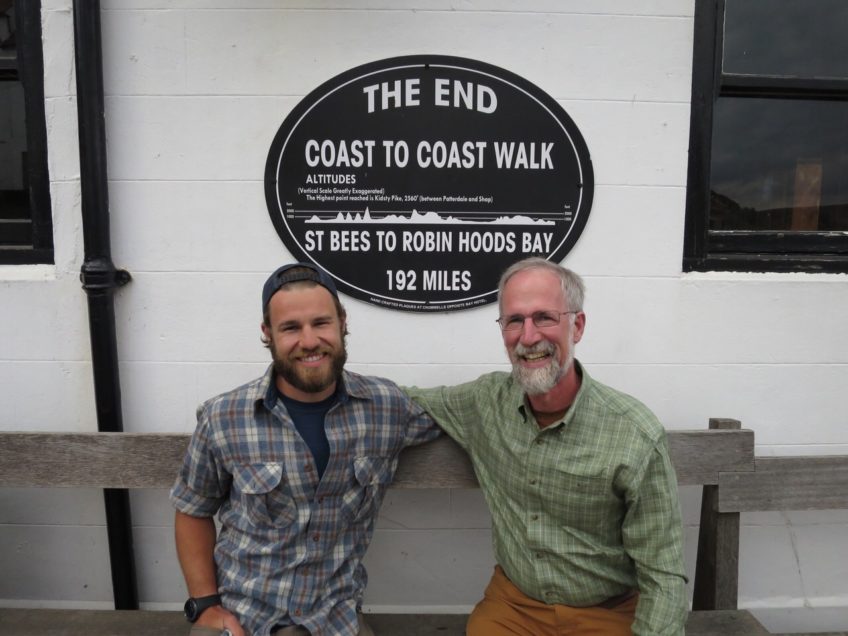As we left our wonderful B&B this morning, I knew our journey was drawing to a close. Yet even though our goal of Robin Hoods Bay lay only miles to our east, Wainwright had an eleven mile journey planned for us. As we dropped into a young forest in the valley below Intake Farm, past waterfalls and a hermitage, I realized the depth of the experience that Alfred Wainwright had created when he mapped out the Coast to Coast path. This path was no straight line sprint from St. Bees to Robin Hoods Bay. Instead, it was a meandering route that highlighted the wonders of the English countryside between the Irish Sea and the North Sea. His path wound through the Lake District, over the high moors of the Pennines and of Yorkshire, and across countless pastures. I can think of no other path like this that I have come across in my experience. In less than two hundred miles, he wove together an experience that was as civilized as it was wild.
Yet as we crested our last hill and beheld the North Sea down below us, we both turned back to admire the countryside we had come from. The heathered and pastured hills that stretched before us stood as a reminder of the beauty we had experienced, but also of the distance we had come. I realized that this was not the first time we had done this. It was not the first time we had looked back in time. Wainwright was just as much a storyteller as he was a trail maker. In effect, he unites his passions in this trail. On countless occasions he follows a roundabout path to ensure that any hiker would appreciate what they were doing, what they had already done, and what they had yet to accomplish. Such vistas illustrated your past, present, and future on the Coast to Coast. At other moments, Wainwright’s trail wandered miles out of its way to visit a favorite wood, beautiful glen, or serene valley. He wanted those places to be the scenes through which your story passed, and would always remind you of them as you looked back from the hill tops high above. I never would have imagined that the art of route finding could be so linked to that of storytelling.
The beauty of Wainwright’s vision is what separates the Coast to Coast from trails like the Appalachian Trail. The AT follows the Appalachian Mountains, following their spine from Georgia to Maine. The Coast to Coast has no defining feature. It wanders from place to place with a goal, but no clear marching order. Anyone can wander at their own pace and their journey is their own. You can wander in silence or in conversation. Walkers are not bound to the exact parameters of Wainwright’s route. In fact, it is hard to truly know what that route is anymore. It has changed with every generation of walkers. It is a living trail, but it lives in the spirit of Alfred Wainwright. His romantic attitudes are what persuade its contemporary hikers to explore ancient stone circles, abandoned lime kilns, or random memorials, even though they often lay afield from the trail. It is a route that encourages exploration, not strict adherence. He took a wide swath of the England and made people equally excited to explore the peaks of the Lake District as they were to wander the moors above Kirkby Stephen. The landscape speaks for itself, but it takes a gifted story teller to weave that landscape into an engaging epic. That is Wainwright’s gift.
From that last hilltop, we descended through fields and pastures towards the sea, passing by towns that felt far more busy and modern than we were used to. The sea did not materialize again until we were almost upon it. Our path crept through a lonely trailer park before reuniting with the Cleveland Way, the National Trail that led us along the tops of the cliffs. As we left that trailer park, I smelled the sea air rushing at me over the cliffs. Soon after, I heard the waves crashing far below. Upon reaching the cliffs, we simply stood there. The North Sea had been our goal for almost three weeks and we were now standing next to it. I have never felt at home by the ocean, but I felt home now. It reminded me of how I often felt when I rounded a curve on Highway 13 outside of Bayfield, finally able to see Lake Superior spread out below me. Afterwards, we meandered along the cliffs as the afternoon light danced in between the puffy clouds. There had been no rain today, just a cool breeze and intermittent, warm sunshine.
Technically, the North Sea was not the end of our journey. Robin Hood’s Bay still lay to our south. We wandered along the cliff tops, stopping for lunch on a high promontory, until the small town came into view. As we grew closer, I realized that it was unlike any town I had ever seen before. The houses were cramped together in a steep valley that dead ended into the sea. Terraces of stacked houses lined the skinny, precipitous street as it plummeted towards the water. A small stream trickled underneath it in a valley it had all to itself. Passageways and alleyways cut into the stacked houses, creating hidden courtyards and high terraces. Formerly a thriving smugglers town, Robin Hood’s Bay had many more passages that we would never find. I could only imagine the labyrinth of tunnels and doorways that had transported illegal good over the years. The town felt crooked, jumbled, and cramped, while simultaneously appearing quaint and humble. It was the seaside version of Diagon Alley, full of charm and vibrant life. And despite its touristy flair, it was the perfect place to end the Coast to Coast. Wainwright could not have chosen a better closing chapter to his story.
After dipping our toes in the water, we tossed our St. Bees stones into the sea. After completing these ritual acts, we headed to our B&B for a shower. We finished our day at Wainwright’s bar with a wonderful meal overlooking the sea. My Dad even had a pint of the local “Wainwright” ale. It all had a weird undertone of sentimentality to it. Wainwright had been our companion for the entire walk and what a journey it has been.

















2 Responses
LaToya
Truly fantastic!
Maureen Ruzicka
Jeremy, I so appreciate you sharing your adventure. Your writing and photos made me almost feel that I was on the journey too. How wonderful that you and your dad could experience this together. A sincere, thank you.